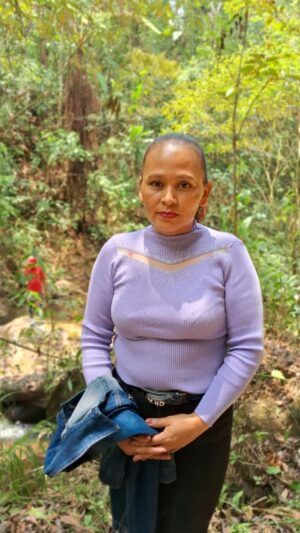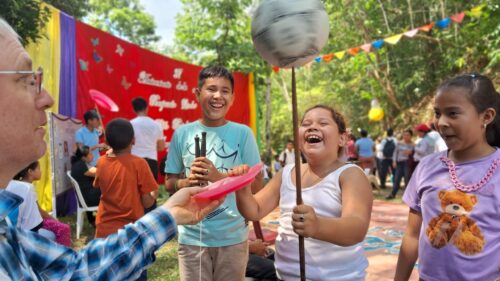Ben Linder: 37 Years, Presente!
“I was three years old when he was killed,” says Xiomara Hernández. “My little brother who is here with me today is the baby, he was just six months old.”
Xiomara is standing on a rock above a rushing stream, looking down on the spot where her father, Sergio Hernández, was murdered along with U.S. engineer Ben Linder on April 28th, 1987. Another fifty meters downstream, Pablo Rosales was killed; shot and bayoneted through the heart. The three were ambushed and murdered by U.S.-backed Contra forces while they were building a weir, measuring the stream to install a hydroelectric system so the rural community of San José de Bocay could have electricity.
We’ve brought a small delegation from Casa Ben Linder in Managua to commemorate the 37th anniversary of the murders, joining 200 people from San José de Bocay for the annual event organized by the Bocay Electrical Service Development Association, APRODELBO. This organization was founded to finish the work Ben, Pablo and Sergio started on the hydroelectric plant and continues to provide electricity to 2,000 people in the region today.
From the beautiful pond created by the small hydro system, we have hiked up the heavily wooded trail to the spot where the three were killed. Xiomara tells me this is only the second year that Sergio’s family has participated – for many years no one knew where they were, and Pablo Rosales’ family still hasn’t been located. Through the magic of the internet, however, Sergio’s family now been found and Xiomara feels it is important to be here.
“It’s very hard, you know?” she says. “It’s painful to be here today, but it’s important to remember.”
In 1987, Sergio and his family were war refugees, having been displaced from their home further north by Contra attacks. For a time, they were part of a farming cooperative near El Cuá, but the El Cedro co-op was attacked by the Contras twice in three years – they killed 17 members and kidnapped 9 others, burned the homes and slaughtered the cattle. Sergio and his wife moved their seven children to San José de Bocay, where he volunteered to work with Ben Linder on a project to bring electricity to the town.
Ben Linder was a peace activist and engineer from Portland, Oregon, who had moved to Nicaragua in 1983 to contribute his skills to the popular Sandinista Revolution. He was a clown and a unicyclist who worked with the popular circuses in Managua. As an engineer, Ben worked to bring electricity to war zones in northern Nicaragua where U.S.-funded contra guerillas attacked villages in the dark – electricity made them safer. After building a successful hydroelectric plant in El Cuá, Ben and his coworkers began work on a new plant in San José de Bocay, near the Honduran border.
Pablo Rosales was a young farmer who had been kidnapped by the Contras the previous year and forced to fight with them. He managed to escape, and then brought his wife and four children into town where they were living in a plastic house in the refugee settlement in San José de Bocay.
On 28 April 1987, Sergio and Pablo went to work with Ben along with other farmers from the refugee settlement. Sergio took the lead as the small group hiked to the construction site. When Ben sat down to write in his notebook, Sergio stood nearby and Pablo Rosales waited aways downstream.
Froylan Jarquín was there that day. “I was part of the Ministry of the Interior at that time, working nearby and my boss called me to say, ‘Get over there.’ When I arrived here at the site, I found the three of them dead. A group of Contra came here and killed them.” Froylan points to the thick tree cover where the Contras had waited to ambush the group, emptying 30 bullets into the clearing.
“They threw a grenade, it landed in the sand and shot fragments everywhere. Down there is where Ben fell,” Froylan says, pointing to a large flat rock in the stream. “And Sergio fell there next to him. Pablo was 50 meters downstream.” The Contra were waiting for them that day because they had orders to kill Ben for the work he was doing on behalf of the Nicaraguan people. Ben was the first North American to be killed by the Contra, killed by the government of his own country of origin, the United States.
Back at the pond, students from the Ben Linder public elementary school and other schools dance folklore, recite a biography of Ben Linder, and have a drawing contest. Our group contributes songs and a juggling show, and everyone breaks four piñatas. The children’s joy is palpable; the spirit of Ben’s playful clowning is present.
“Last year was the first year I was here, I came on my own,” says Xiomara. “But this year, three of my father’s kids are here and many of his grandkids. My dad has 31 grandkids now, and our family is still growing.”
Xiomara introduces us to her sister via video call, Isabel Hernández grins at us from her hammock in the North Caribbean Autonomous Region, and assures us that she’ll be here next year with her family in tow.
After the event, we go to see the hydroelectric plant run by APRODELBO, the Nicaraguan organization that represents the legacy of Ben Linder, continuing to fulfill his dream of renewable energy for the region.
They tell us that just this week they have just finished installing electricity to 85 houses built for families living in extreme poverty in the Barrio Benjamín Linder. The new homes were built by the Nicaraguan Housing Institute and the municipality of San José de Bocay, and were given free of charge to the families, complete with a stove and gas tank. José Luis Olivas, head of the environmental management unit of APRODELBO, drives our group out north of town to see the new houses at dusk, just as the lights are coming on in the yellow and lavender and green homes.
I marvel at the sight, thinking that the project is a worthy tribute to the spirit of Benjamin Linder: the joy of colorful houses, the most vulnerable families cared for, the renewable energy that provides electricity, light and safety. We can feel the spirits of our heroes and martyrs, Ben, Pablo and Sergio, are indeed ¡presente, presente, presente!
After seeing how much things have changed for the better for the people of Bocay in recent years, we return to the hotel where I am immediately reminded that the treatment of Nicaragua by the United States remains the same as it was in 1987. We find urgent messages waiting for us from our colleagues in the Nicaragua Solidarity Coalition in the U.S. “We just found out that the new sanctions package against Nicaragua will be voted on by the full Senate any day now!”
We wave goodbye to Xiomara and her family and immediately sit down to send out emails and post on social media to gather signatures against the latest in a long list of U.S. aggressions against Nicaragua going back 200 years to the Monroe Doctrine.
Why is the U.S. targeting tiny Nicaragua yet again? Two weeks ago, Nicaragua brought Germany to the International Court of Justice for aiding and abetting Israel’s genocide of the Palestinian people. This Tuesday, the ICJ will hand down its initial ruling, and the U.S. Senate plans to immediately punish Nicaragua for defending Palestine with further illegal unilateral coercive measures. In the spirit of Ben Linder, the peace activist who gave his life for Nicaragua, I will do everything I can to stop these sanctions. I hope you will join me – please sign here to tell the U.S. Senate to say NO to more sanctions on Nicaragua.
 APRODELBO Installing electricity in Barrio Benjamin Linder
APRODELBO Installing electricity in Barrio Benjamin Linder
 Xiomara Hernandez, daughter of Sergio Hernandez
Xiomara Hernandez, daughter of Sergio Hernandez

No comments:
Post a Comment